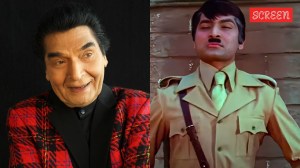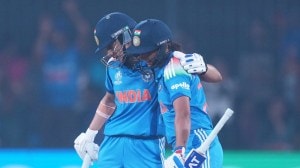Why Bhiwandi’s Muslims rail about POY, not POTA
Like silkworm cocoons on ultra fast forward, the century-old loom spins thread busily in the humid warehouse-like building. Outside, goats l...

Like silkworm cocoons on ultra fast forward, the century-old loom spins thread busily in the humid warehouse-like building. Outside, goats lord over a slushy compound, their pen occupied by a late-model Honda City.
Tommy Hilfiger. Old Navy. Gap. The West’s best brands are born in the dank sweatshops as brilliantly hued bales of cloth in this creaking, teeming, overwhelmingly Muslim town—and others like it—that serve as India’s textile back office to the world.
Glowering beneath his bushy eyebrows, Sheikh Razak (35 he says, but he’s really not sure) is acutely aware of the seven-hour power cut that could at any time stop the loom he’s supervising: He knows the frailties of the colonial-era antique better than any IIT mechanical engineer.
Sheikh Razak’s qualifications: illiterate (he can sign his name though). Yet, he earns Rs 15,000 as ‘‘technician’’, just one of the more than half million workers (in a town of 1.3 million) whom the looms have raised from destitution to hope.
‘‘I came here from Aurangabad in the dushkal (famine) and used to earn Rs 10 a day in 1980 buying vegetables for the seth,’’ explains Razak. ‘‘Today two sons are in school, one who wants to be a policeman in Marathi medium, the other in Urdu medium.’’
Solapur to the south, Malegaon to the north and Bhiwandi—half of India’s powerlooms and 80 per cent of textile cloth comes from this squalid but hard-working town, 50 km northeast of Mumbai—are full of Muslims who are moving up the great Indian economic escalator, step by painful step.
In 28 assembly constituencies (of a total of 288) where Muslims aspirations control up to 40 per cent of the vote, could lie swings that that could become critical in the emerging dead-heat between the NCP-Congress and the Shiv Sena-BJP.
But from Mumbai to Malegaon to Bhiwandi, it’s becoming increasingly clear that the Muslim vote is evolving around economic ambitions. The unified Muslim vote bank, bloody riots and the now-scrapped POTA (under which a record number of 83 mostly Muslim suspects were detained since 2003 by the NCP-Congress regime), just aren’t mass Muslim issues.
The Urdu papers across Maharashtra are full of warnings to Muslims not to split the Muslim vote, to select candidates carefully after examining their stand on local issues.
‘‘What matters to this town is the future of the looms,’’ admits Shujauddin Nizamuddin Ansari (37), Bhiwandi’s Congress candidate, who focusses mainly on living conditions in the squalid worker shanty towns, the power cuts, and his town’s biggest issue—POY, or Partially Oriented Yarn—and biggest enemy: not the Sena but the Ambanis.
The anger is over a decade-old Reliance monopoly over POY, a critical raw material for cloth-making. Reliance, the town alleges, persuaded the Union government to slap an anti-dumping duty on Korean, Taiwanese POY, converting a free market into one ruled by rampant dealer speculation.
Despite his family’s rise from rags (his father, a migrant from Allahbad worked the looms, sometimes 48 hours at a stretch) and Rs 1 crore annual turnover, Ziauddin is vehement that his sons will not follow.
Yet it is the scent of a mass ‘‘Muslim hurt’’ that draws Abu Azmi, Samajwadi party candidate and former MP from Mumbai to Bhiwandi.
Azmi, himself an ex-TADA detenu, made the strange journey to Bhiwandi and unlikely climbdown from MP to prospective MLA, say his supporters, so he could be a minister. His gamble: parties like the SP will play a critical role in a hung assembly.
‘‘But Azmi’s POTA talk won’t get him anywhere,’’ says M Abubaker, editor of local Urdu weekly Halaat, who points out Bhiwandi’s last communal riot was in 1984. ‘‘This town always elects one its own, someone whose door it can knock on in the middle of the night.’’
The Congress has a clear edge, because it was in 2003 that a debilitating 2 per cent excise tax—which sent the looms into a tailspin—slapped by the previous BJP-Sena government was removed. The sitting MLA was from the obscure Muslim OBC Sangathna, but supported by the Congress, which doesn’t now, so he’s of course turned rebel. It helps that POTA is gone, though no one realises its replacement is more stringent.
In the last five years, Bhiwandi and towns like it have seen the birth a consuming class—albiet at various economic levels—that accounts for the flood of new scooter and television dealerships, the traffic meant for the new flyover under construction, the stream of schools, techical colleges and two girls colleges.
‘‘Seven years ago we had only one college, now everyone wants their children to study,’’ says Pradeep Raka, a Marwari jeweller who makes up Bhiwandi’s startlingly diverse mosaic of peoples.
There are Telugus—Andhra CM Y S R Reddy was brought in by the Congress to woo them—Marwaris, Marathas, and the Muslims themselves are from all corners of India.





- 01
- 02
- 03
- 04
- 05


























